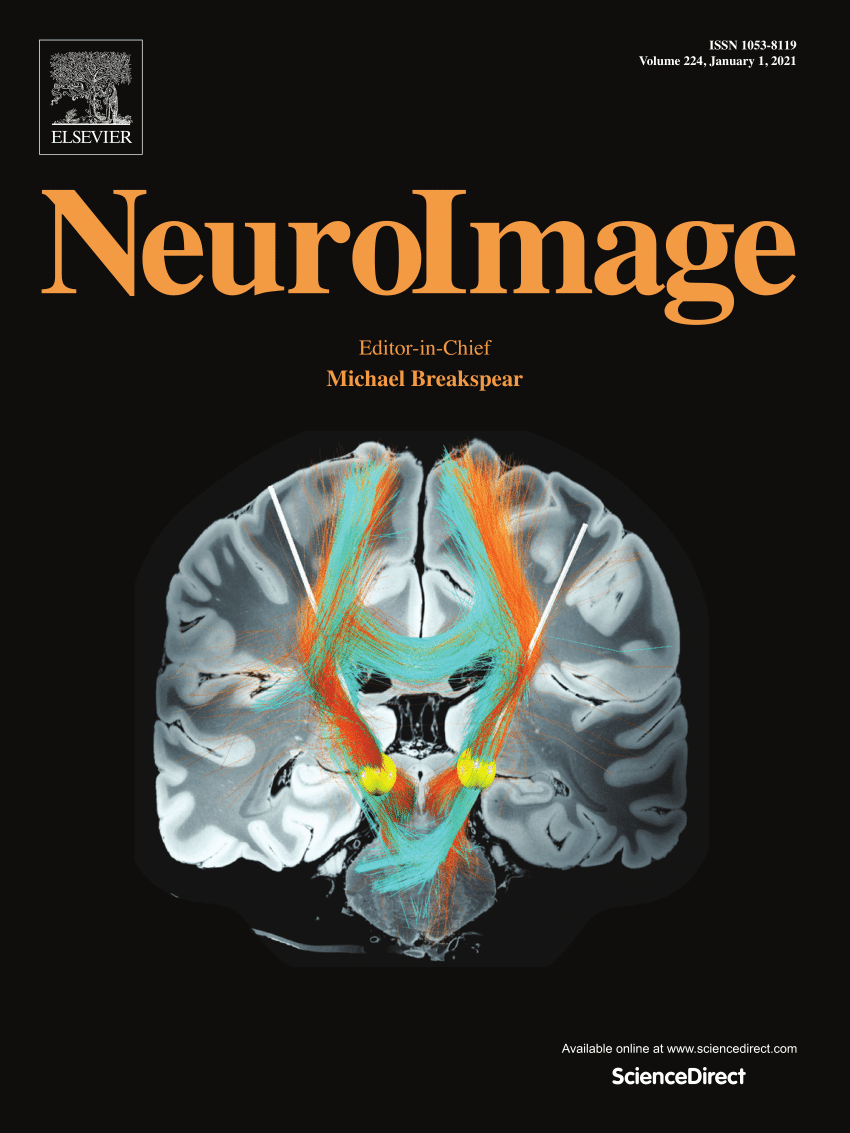拮抗网络靶向tDCS对大脑共激活模式的影响取决于网络的电场:一项同步tDCS- fmri研究
IF 4.7
2区 医学
Q1 NEUROIMAGING
引用次数: 0
摘要
脑网络应该是非侵入性脑刺激的理想目标,因为网络功能障碍是各种神经精神疾病的共同特征。了解神经网络靶向刺激的机制对推进其临床应用至关重要。材料与方法本研究采用同步网络靶向经颅直流电刺激(tDCS)和功能磁共振成像(fMRI)来研究tDCS靶向拮抗网络对脑动力学的影响。共有143名健康参与者被招募并被分配接受中央执行网络(CEN)靶向tDCS (c -目标组),默认模式网络(DMN)靶向tDCS (d -目标组)或假手术tDCS(假手术组)。收集所有受试者的fMRI数据,分为刺激前、刺激中、刺激后三个部分。采用个体头部模型模拟个体电场强度。确定了六种反复出现的大脑模式(共激活模式,CAPs)。计算了这些cap的时间指标(发生时间、分数时间、持续时间)及其转移概率。本研究首先考察了c -靶向/ d -靶向/假tDCS对颞叶指数的影响,并进一步探讨了脑网络EF强度对颞叶指数改变的贡献。结果sc靶向tDCS显著增加了DMN主导的cap的时间指标和其他cap向DMN主导的cap过渡的概率。同时,在c靶tDCS过程中,CEN主导的CAP时间指数下降,向这些CAP过渡的概率也有所下降。相比之下,d靶向tDCS对脑动力学只有轻微的影响,而假tDCS没有明显的影响。进一步的融合分析显示,在刺激期间,显著性网络中的EF强度对cap的时间指数有很大的贡献,这突出了三重网络之间的紧密相互作用。此外,将大贡献网络的EF强度与刺激前时间指数相结合,可以有效预测刺激过程中cap的时间指数。这些发现表明,针对c的tDCS可以调节脑动力学,并强调了刺激过程中网络EF的关键作用。结论本研究证实了网络靶向tDCS调节脑动力学的有效性和可行性,为治疗以脑动力学异常为特征的神经精神疾病提供了新的选择。本文章由计算机程序翻译,如有差异,请以英文原文为准。

Effects of antagonistic network-targeted tDCS on brain co-activation patterns depends on the networks’ electric field: a simultaneous tDCS-fMRI study
Background
Brain networks should be ideal targets for non-invasive brain stimulation, as network dysfunction is a common feature of various neuropsychiatric disorders. Understanding the mechanisms of network-targeted stimulation is essential for advancing its clinical applications.
Material and method
The current study utilized simultaneous network-targeted transcranial direct current stimulation(tDCS) and functional magnetic resonance imaging (fMRI) to investigate the effects of tDCS targeting antagonistic networks on brain dynamics. A total of 143 healthy participants were recruited and assigned to receive central executive network (CEN)-targeted tDCS (C-targeted group), default mode network (DMN)-targeted tDCS (D-targeted group), or sham tDCS (sham group). fMRI data with three sections (pre-stimulation, during-stimulation, post-stimulation) were collected across all subjects. Individual electric field (EF) strength was simulated using individual head model. Six recurring brain patterns (co-activation patterns, CAPs) were identified. The temporal indices of these CAPs (occurrence, fraction time, persistence time) and their transition probabilities were calculated. This study first examined the effects of C-targeted / D-targeted / sham tDCS on temporal indices and further explored the contribution of brain networks’ EF strength on the altered temporal indices.
Results
C-targeted tDCS significantly increased the temporal indices of CAPs dominated by DMN and the transition probabilities from other CAPs to DMN-dominated CAPs during stimulation. Meanwhile, the decreased temporal indices of CAP dominated by CEN, and its transition probabilities to these CAPs were also found during C-targeted tDCS. In contrast, the d-targeted tDCS had only a slight effect on brain dynamics, while sham tDCS showed no significant impact. Further fusion analyses revealed that the EF strength in the salience network made a large contribution to the temporal indices of CAPs during stimulation, highlighting tight interactions within the triple networks. Moreover, integrating the EF strength of networks with large contributions and the pre-stimulation temporal indices effectively predicted the temporal indices of CAPs during stimulation. These findings suggest that C-targeted tDCS can modulate brain dynamics and emphasize the critical role of networks’ EF during stimulation.
Conclusion
This study demonstrates the effectiveness and feasibility of network-targeted tDCS in modulating brain dynamics, providing a new choice for treating neuropsychiatric disorders characterized by aberrant brain dynamics.
求助全文
通过发布文献求助,成功后即可免费获取论文全文。
去求助
来源期刊

NeuroImage
医学-核医学
CiteScore
11.30
自引率
10.50%
发文量
809
审稿时长
63 days
期刊介绍:
NeuroImage, a Journal of Brain Function provides a vehicle for communicating important advances in acquiring, analyzing, and modelling neuroimaging data and in applying these techniques to the study of structure-function and brain-behavior relationships. Though the emphasis is on the macroscopic level of human brain organization, meso-and microscopic neuroimaging across all species will be considered if informative for understanding the aforementioned relationships.
 求助内容:
求助内容: 应助结果提醒方式:
应助结果提醒方式:


